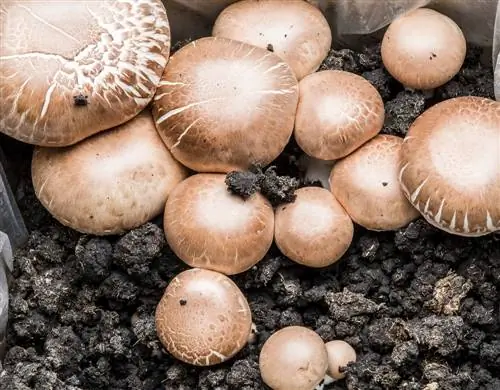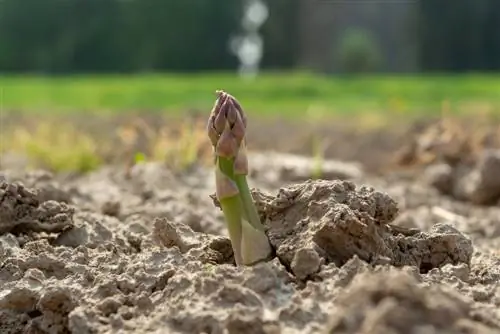- Author admin [email protected].
- Public 2023-12-16 16:46.
- Last modified 2025-01-23 11:20.
It used to be part of midsummer walks in the forest to collect fresh and aromatic wild blueberries for fresh consumption or for preserving. Nowadays, large fruits can be easily harvested from cultivated blueberries in the garden.

What should you consider when planting blueberries?
When planting blueberries, acidic soil with a pH between 4.0 and 5.0 is important. The location should be loose and permeable; light partial shade is ideal. Planting distance for cultivated blueberries: 1.5 m in the row, 2.5 m between the rows.
What do you need to keep in mind when planting blueberries?
It is important for planting all blueberry varieties that they originally come from boggy areas with loose soil and an acidic pH value between 4.0 and 5.0. Since most gardens in this country have different pH values and soil that is often loamy or very calcareous, the soil substrate usually has to be replaced first at the planned location. Since blueberries have more broad and shallow roots than deep, the planting hole should be dug accordingly and filled with acidic soil.
Where can you plant blueberries?
The wild blueberry Vaccinium myrtillus, which can also be found in the forest in this country, usually does not tolerate a location in full sun. These blueberries, which remain relatively small and produce little yield, should therefore be planted in partial shade. However, you can also grow the following cultivated blueberries in full sun to harvest large and sweet fruits:
- Vaccinium Pilot
- Vaccinium Bluecrop
- Vaccinium Earlyblue
In addition to the acidic pH value in relation to the soil, it is also important that it should be loose and permeable. Although cultivated blueberries need a sufficient supply of water before the harvest season, they do not like their roots to be waterlogged.
Can you still transplant larger blueberry bushes?
A cultivated blueberry bush that was planted in the garden at a height of around 30 cm can, with good care, reach a height of up to 2 meters after around 3 to 4 years. With this type of plant, too, transplanting becomes more difficult as it grows larger. Nevertheless, in autumn and, if necessary, in early spring, there are good conditions for carefully planting in a new location. The shallow roots should be cut out in as large a diameter as possible and cut back slightly to compensate for the initially reduced root activity of the bush. If you plant blueberries, you should always water them a little in the first few days after planting.
How can you propagate blueberries yourself?
Wild blueberries often reproduce relatively strongly via root runners. This is less the case with cultivated blueberries, but they can also be propagated relatively easily using cuttings and planters. To do this, cuttings are placed in an acidic growing substrate or branches that are still on the bush are weighed down near the ground for several months and piled up with a little soil.
What is the best season for planting blueberries?
The wild and cultivated blueberry varieties all perform best when planted in the fall. If necessary, cultivation is also possible in early spring before the leaves emerge in frost-free weather.
When do blueberries bloom and when are their fruits ready for harvest?
Blueberries always produce their flowers on the leaf buds the previous year, and in Central Europe the visible flowering phase usually occurs in the first two weeks of May. The fruits can be harvested from the beginning of July at the earliest and sometimes until September.
What should you consider when preparing the soil for blueberries?
If you have very clayey or lime-rich soil in your garden, you will have to replace the soil at the planned location for the blueberries to a depth of around 50 cm. To fill the planting hole, ideally use special soil for rhododendrons or azaleas. If you want to avoid peat-containing soil from garden shops for ecological reasons, you can generally “acidify” lime-poor soils by adding bark mulch and spruce needle compost. You should also pay attention to loose soil, as all blueberry varieties tend to suffer from deficiency symptoms when they are heavily waterlogged.
At what distance should you plant blueberries?
The distances to be maintained when planting depend to a large extent on the choice of plants. Due to their small height and width, wild blueberry varieties such as Vaccinium myrtillus do not require a particularly large planting distance from one another, especially since in nature they often overgrow entire clearings like ground cover. When it comes to cultivated blueberries, there are also small varieties for pots that only require around 50 cm of space on each side, even outdoors. Most cultivated blueberry varieties grow up to 2.5 m high and almost 2 m wide. Therefore, when planting in rows, the planting distance should not be less than 1.5 m. The rows should be about 2.5 m apart so that you can easily walk through them when collecting the fruit.
Tips & Tricks
For cultivated blueberries, regular fertilization is recommended to ensure a correspondingly high yield. However, this should definitely be carried out with suitable fertilizer without lime content. In addition, products designed for flowering plants should be checked to see whether they are also approved for growing fruit plants.






